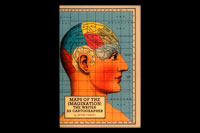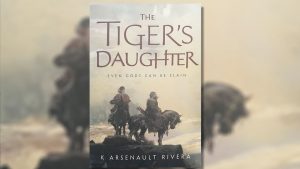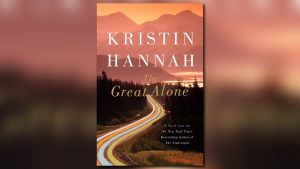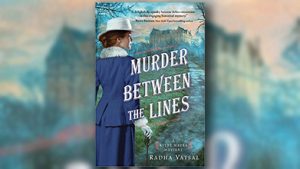Using the map as metaphor, Peter Turchi considers writing as a combination of exploration and presentation, all the while serving as an erudite and charming guide.
He compares the way a writer leads a reader through the imaginary world of a story, novel, or poem to the way a mapmaker charts the physical world.
Turchi explores how mapmakers and writers deal with blank space and the blank page; the conventions they use (both the ones readers recognize and those that often go unnoticed) or consciously disregard; the role of geometry in maps and the parallel role of form in writing; how both maps and writing serve to recreate an individual’s view of the world; and the artist’s delicate balance of intuition with intention.
Alberto Rios: Welcome to Books & Co. We're joined today by author and educator Peter Turchi who's going to be talking about his book Maps of the Imagination: The Writer as Cartographer, published by Trinity University Press. Pete, welcome. I'm glad you're here today.
Peter Turchi: Thanks, it's a pleasure to be here.
Alberto Rios: Your book is a book about books. It's a book's book I think. And it reminds me of some other books that have had that great ambition, maybe Alberto Mangel's book The History of Reading or Gabriel Aaid's book, so many books, books that help us think about how to read, not just telling us that we read, but how to read. And you used the great metaphor, maybe the objective correlative of the map to accomplish this. Could you tell us about your thinking process as you put these together.
Peter Turchi: Sure. I'm kind of intuitive and digressive thinker. My goal is quite practical.
It wasn't metafictional at all, but I was trying to write about writing for people interested in working on their writing in a way that was both practical or at least useful but also unlike typical writing handbooks, so it's not meant to be a book of instruction and somebody finishes a book and says it doesn't tell me exactly how to do anything, that's ok by me, because it's not meant to be that kind of thing. It started out really as an examination of kind of puzzle that I'd recognize in myself and that is a lot of people say they talk with great pleasure about being lost in a book and it's one of the things we sometimes feel we lose as we get older, that we don't have the depth of concentration when we read we did when we were kids and the world disappeared when you read and you'd lose track of time and all that, for a variety of reasons we find it harder to do when we get older.
Alberto Rios: That is a great word, lost.
Peter Turchi: The notion is you're transported, somewhere else, out of this world and into the world of the book, story, poem, whatever you're reading. But what intrigues me about that is that that's very different from saying, say, I'm lost in my calculus textbook or lost in this American history text. Meaning it's too dense or I've lost track of all the details or something like that. It's a pleasurable kind of lost. And so I thought, all right, so as a writer if I were to recreate that experience I so enjoy as a reader, what does it mean to try to get a reader lost? And I realized that I don't want to baffle a reader or confuse a reader. In fact I want to guide a reader.
Alberto Rios: Well, you make that very important distinct early on between explorer and guide.
Peter Turchi: Right. There's I think there are two stages I mean there are obviously different parts of the process of writing and the first part is really an act of exploration where you're discovering the story you want to tell or the novel you want to write or the poem you want to write or the song I imagine you want to write or essay. And then the guiding is the act of authority that gives the author his prominent position, act of guiding the reader from beginning to end, sometimes pretty explicitly and clearly and comfortably saying if I'm writing a memo and I want to convey certain information, I want to be a clear and accurate guide, pretty reliable. But if I'm writing a short story, I might well want to trick the reader or lead the reader to look in one direction while I'm busy doing something else. So guiding can be -- there could be a little trickster nature to that too.
Alberto Rios: You're describing the work of a magician.
Peter Turchi: Well, it's interesting, one of the resources I came upon someone suggested while I was working on this was the work of Edward Tufte who talks about information design. And he refers to the descriptions of magic tricks as disinformation design. He talks about what the magician needs to see and know and think about as compared to what the audience needs to see and not see and not think about, and that disinformation design is what allows a trick to be a trick. So that we think we're seeing a woman cut in half, for instance, and of course with any luck at all that's not at all what's happening.
And while a writer isn't necessarily doing those things, even the writer say of a pop song doesn't want his audience to thing about the formulaic nature of a pop song but instead wants to convince the listener the song is unique and different even throw it too is three minutes and 27 seconds long and has three verses and a chorus like so many other pop songs.
Alberto Rios: Those sorts of things also presuppose that the writing itself is already good, that the disinformation is only part of the story.
Peter Turchi: Well, right. If we don't have good writing we're sort of out of luck I guess.
Alberto Rios: Right.
Peter Turchi: But what intrigues me or when I was addressing writing students which is who I had in mind when I started to articulate these ideas, is that often people would put words on the page and even though they'll revise those things, they'll think of ways to improve those, often it seemed with my own students they weren't really further exploring the world of the story, and there's that impatience to get to the final draft or the final versions once you have a notion in mind, and in fact often very exciting things happen after those first few drafts, and it requires a kind of stamina, and so my comparison in the book is to explorers as opposed to map makers, when an explorer heads out he may have a particular goal, be looking for a particular northwest passage or the north pole, particular place, but often the discoveries are only tangentially related to the presumptive goal.
Alberto Rios: Right. And coming back he then perhaps creates a map or gives that information to somebody, and you have this wonderful line that every map is a story.
Peter Turchi: Every map tells at least a story and maybe that story seems uninteresting in some cases, if you're thinking of a road map and the story is these are the major roads of Arizona, that doesn't seem so exciting, but then there are other maps which pose stories which are pretty interesting. My son, for instance, has a -- he's fond of the eastern chain steak and shake. So he has a map of the east according to steak and shake, and that tells a particular story about an obsessive desire for food or on the company's part, desire to lead us through the landscape in a certain way. And you used to be able to use Mapquest, maybe you still can, by not only planning your route to a destination but also choosing a certain hotel chain that you wanted to stop at or certain food chain, and then there are artistic maps of a landscape, maps, say, of birding sites. We have bald eagles nesting now, and people are charting not only where those nests are, but where the birds fly and when they're here so they're temporal maps. Those maps tell stories, and usually when we gather our knowledge, whether on a map or in a story or poem and then look at it, we start to think about it in new ways and so in fact gathering our information raises new questions and so the process doesn't end.
Alberto Rios: So maybe that word disinformation might be we can refine it or think about it as the very specific information the author wishes to convey to the reader.
Peter Turchi: Well, there's information we want to convey and then there's a certain amount of sleight of hand involved as I said. There's an artfulness to deciding when to reveal information and when to conceal information.
Alberto Rios: I think Voltaire said illusion is the first of all pleasures, right?
Alberto Rios: A teacher of mine used to say that the first lie of fiction is that it's the truth -- that is, a story starts out by saying once upon a time this happened. We know it didn't happen, but to enter the world of story we have to believe it at least for the length of time we're reading it.
Peter Turchi: Well, we have words that are giving us the story and maps giving us the landscape, but you have a wonderful discourse in the book about blank spaces.
Alberto Rios: Yeah, I tried to poke and pull the metaphor in various ways as it inspired me and I read a book by a fellow named Dennis Wood, who was trained actually in English but took up critical cartography, new to me, and he talks about the importance of what's left off a map. Not only politically, and of course we flow for instance when explorers came here and mapped the country and left Native Americans off, that that was a strong political statement and implied there was really nobody here, nobody of consequence. But then there are other kinds of blanks as well. Many of which just leave room for information. If everything that could be mapped in even the physical world were placed on a road map, you wouldn't be able to read anything. There would be so much information that you couldn't get to the information you want. So every map is in fact defined by what it leaves out, and anybody who's tried to write a novel, even a short story and probably a poem, but Serge anybody who sits down to write a novel at some point realizes it could go in many different directions and it's not that there's a right book to write and all these other wrong books to avoid, but in fact there are many interesting stories to tell and you have to choose one.
Alberto Rios: You're describing that way that we can maybe map too much, the great Voorhees story where the map gets bigger and bigger and finally is the thing it's trying to map, right?
Peter Turchi: Exactly. I think that's the universal history of infamy, and he points out that there's nowhere to put that map, but also there's no need for that map, because it -- the world is already the map that includes everything. So a map is necessarily selective in the same way that a story or a novel, even a big novel, even a Dickensian novel, good 700-page book leaves a lot out. Thomas Wolfe and F. Scott Fitzgerald had a famous argument about taker outers and putter inners, but Wolfe defended himself by saying that even in those big books of his he was omitting things. He says you can't write anything without leaving things out.
Alberto Rios: Well, if we go further with that, I mean, that notion of leaving out, putting in, we're assuming we're in control as writers or readers, but there's the physical aspect that we have no control over and the problem with the metaphor of the map that maps themselves are – have some difficulty rendering the world and the merc atr projection as opposed to Peter’s projection and other maps have solved this in various ways, but there's a physical aspect related to all this.
Peter Turchi: I would say they've addressed it in different ways. The problem is everybody remembers from early geography or social studies classes, the earth is a globe, irregular oblique spheroid, not a nice circumstance and to plot that on a flat piece of paper necessarily involves some distortion, and so sometimes cartographers refer to various cartographic projections as distortion formulas and you can choose to preserve shape or distances in certain parts of the globe and so be relatively accurate, but you're never accurate about everything in all places, not yet anyway possible. So in the same way, when you choose to render a world on the page in fiction, you're making certain choices. Now, for instance, realism is probably the most dominant distortion formula in fiction.
Alberto Rios: Great line. Should stop and savor that for a moment.
Peter Turchi: What I think writers often forget and readers intuitively know this, what writers often forget is that realism is a distortion, it's not reality. It's realism. And so we don't portray dialogue on the page the way people actually speak because that would be tedious and there's a lot of misspeaking and dull dialogue you wouldn't want to read in a story. So dialogue in fiction is actually quite selective and representative and in every other way, we have a notion of reality, even in what purports to be a very realistic novel.
But there are other distortion formulas as well, and so we can read David Foster Wallace or we could read our romance novel, we could read a comedy of manners, and all those are distortion formulas that we can adjust to pretty quickly so we can read, for instance, I was just talking to some people about Truman Capote's wonderful Breakfast at Tiffany's.
It has a young woman, borderline prostitute, Holly Go Lightly, she gets involved with a mobster and conveys information for the mob. But it's a very light hearted romance. And we can understand the tone of that world and how we're supposed to enter into it and nobody takes it too seriously, although you can see the same material handled in The Sopranos or Martin Scorsese film and it has a very different tone and we respond to it and have different expectations for it.
Alberto Rios: You talk about Lolita in the same way as well.
Peter Turchi: Right. Lolita is a book I keep coming back to because it's a haunting
one.
Alberto Rios: I just reread it myself, and it is a haunting book, especially for our times.
Peter Turchi: What interests me, John Updike died not so long ago and I've also taught his Rabbit novels and I'm intrigued by those and one of the things that interests me is that many readers and writers are more offended by or more uncomfortable with Harry Angstrom, the main character, because he's sexist and racist and generally kind of brutish and selfish. But many readers are less patient with him than they are with Humbert Humbert, Vladimir's serial rapist and I think one of the reasons is when you read Lolita you know you're in an artistic representation of the world. It doesn't feel real in any normal way, whereas Harry seems very realistic.
Alberto Rios: Let me take a moment to remind our viewers you're watching Books & Co. I'm Albert Rios, your host, we're joined today by Peter Turchi, who's talking about his book, Maps of the Imagination, The Writer as Cartographer. Pete, as I'm looking through the book, it's full of wonderful, wonderful maps. You use it in the title. But they're there. And I wonder if you could say something about assembling the book.
Peter Turchi: I'd be happy to. The -- one of the things I knew I wanted to do with the book was include a lot of the visuals I had gathered as I was thinking these things through, for instance, there's a map of the title of the map is a little misleading, called the upside down world.
Alberto Rios: One of my favorites.
Peter Turchi: I picked that map up visiting Australia years ago, and it shows the map we'll say upside down, although it's mislead, south is at the top, north at the bottom.
And Australia is at the center of it, which is perhaps the most disorienting thing because we're used to having United States if not front and center, just to the left of center and above it, in a pretty prominent spot. But on that map the United States looks very small and upside down and off to the side. And it's interesting how it makes us rethink our view of the world, and it reminded me as it reminds probably everybody from the northern hemisphere who sees it, that having the north at the top of a map is just a convention. There's no up in space. There's no reason for north to be at the top of maps and in fact the east used to be what maps were centered around.
Alberto Rios: It's a great piece of information. Can you talk a little bit about the east being the top? It was just again where people imagined they needed to go.
Peter Turchi: Well, the sun rose there, so it made sense to look east, then there was a sense that Eden or some promised land, if you didn't believe in Eden, was to the east.
Orient was to the east, so oriented to the east. But for all kinds of reasons, there are maps, for instance, we might think that north is typically the top of maps. But if you go to Disneyland and get a map of the park it's quite possible there's no compass rose on the map because it doesn't matter where north is. You need to know where the front gates are and the roller coasters in relationship to that. So often we don't get compass bearings on a map at all. But for a lot of maps we're used to having north at the top. So to have things changed is disorienting, and in fiction or poetry if you're used to things conveyed a certain way and suddenly the world is presented quite differently in Thomas Bernhart's novel The Loser, the entire book I think just under 200 pages is written in five paragraphs, the first four paragraphs are over by the fourth page I think. And so you're essentially reading a novel which is a single paragraph. Even that small change is pretty disorienting. Feels like there's no time to take a breath. So it's a small departure from convention. E.L. Doctorow often doesn't use quotation face marks around dialogue, maybe now he's abandoned that altogether. And that small change changes the way we hear the characters and relate to them.
Alberto Rios: Sure. You have that great line also, every map intends not simply to service but to influence us.
Peter Turchi: Oh, yes. And many of the people I read about critical cartography, J.B. Harvey and Dennis Wood and Mark Marmoniet, they talk about how quite deviously maps are meant to influence us or promote someone's vision, sometimes quite aggressively. The steak and shake map is an example. Disney world map is likely not to have distances, we want to know we have to walk a mile to the roller coaster, nobody wants to know we have to walk the mile but we'll make the hike without knowing the distance, so information is suppressed for a particular reason. You know, in a book or in a story or poem or song, there may be reasons that we bring certain information to the surface and let other information fall to the background, but the illustrations in the book are varied, not all maps either. One of the things that I wanted to write about is very formal work, because often writers in the realism tradition or readers who think they're most comfortable with realistic books and stories are worried about work that looks either very formal or stylized or experimental that strange word which doesn't really have a single meaning, that means it looks different than everything else I'm used to.
And one of the things that intrigues me is that it's actually a popular art that is the most formal. A sitcom on network television is very strictly defined, be only in the time that's allowed but in the dramatic beats allowed in the show. It's actually a very rigid formula to try to write for a network television show. The same is true for a popular song. If you want to be on A.M. radio you cannot write a seven-minute song. That's not one of your options. My example in the book for that is game boards and how people can say look at a chess board, which is really very abstract, it's a representation of two kingdoms, land being fought over by two different kingdoms, and it's represented by a series of grids, and a child can play chess, or a child can…the chess board and know what's going on. A child can look at a checkerboard which is even more abstract and understand the game that's going on, then there's a picture in the book of Roadrunner and Coyote, Chuck Jones made himself a list of constraints, a list of rules that all the Roadrunner cartoons had to meet.
He invented the characters and created that series and then he made this list of rules. And you don't need to know them to watch them. But if you watch 40 Roadrunner cartoons, you become aware of the constraints placed on it and then the ingenious thing is to keep working new variations on it. So formal work or constrained work is not necessarily more difficult, which is why we can enjoy a sonnet and not say Oh, another 14-line poem. Tired of there.
Alberto Rios: It's a great observation, a very useful one. The book is full of useful inspirational kinds of things like that, that help us break out of the habit of reading as we've been doing it and reexamine it. I think the maps, I'm going to go back to the maps for just a moment, help us see that in that they not only teach us to reread something, but then they do it over and over and over again. You don't let us off the hook. There's a great quotation by G.K. Chesterton I think that there's a great deal of difference between an eager man who wants to read a book and a tired man who wants a book to read.
Peter Turchi: That's interesting.
Alberto Rios: And I think you're giving us the impetus to be that eager person who wants to approach a book with new tools, new ways to do it.
Peter Turchi: I hope so. I'm intrigued. I don't talk about Google Earth in the book, but I'm intrigued by the fact that whenever anyone is introduced to Google Earth it seems the first thing they do is look up their house, someplace they've been, and then look at it from that satellite view and try to find, you know, their neighbors or friends or house they grew up in or whatever it is. You want to see what you already know in some new way. And that's what fiction and poetry and the other arts tend to do I think, and the challenge for the writer is to keep providing that new lens, to keep trying to find a new way to render the world.
Alberto Rios: That's right, make it new. So much of the book comes out of your life. We want to think it's an act of the intellect, but we live lives as writers and we eat lunch and so on. You have the very funny anecdote about being called on to answer where north is.
Peter Turchi: It's funny now. When I was in grade school our teacher asked us the simple question, you know, who could point north, and we actually had the compass directions up on the walls of the classroom but I didn't bother to look, because I knew north was up.
Alberto Rios: North was up.
Peter Turchi: And she laughed, the class laughed, so I remembered that lesson for quite a while. But those conventions, the interesting thing is they challenge our actual experience, I mean, it probably -- I knew north was not up, but from the maps that hung on the classroom walls I had that convention in mind.
Alberto Rios: It's a very funny story. You yourself were here in Arizona to begin with many years ago, you left and spent quite a long time in North Carolina and you're back now in Arizona. So you've been not only up but left and right across the American map. Has that changed your thinking about writing itself?
Peter Turchi: I don't know if it's changed my think building writing but I am intrigued by the fact that place is defined by the kind of maps, I have maps wherever I go, maps of Arizona, historic sites, hiking trails, all that. But then there's the maps I have in mind and one of the things when I lived in Tucson, made Tucson such a reassuring place, is you had mountains to the north and the roads were in a grid and I always felt quite comfortable in Tucson for that reason. When I moved to Chicago from Tucson, well, when I moved to Chicago and everybody said it's the same thing but the lake is always to the east, but you can't see the lake. I mean that's useless. There were buildings in the way of the lake so I always felt lost trying to find my way through Chicago. But coming back to a landscape, coming back here to the cactus, desert, to a landscape that feels familiar now and welcoming makes it a kind of home even though I had never lived here before.
Alberto Rios: Well, I wonder if we can think of acts of landscape as giving us some embrace that in the same way that in your book you imagine us into maps, maps into literature, if certain books then can give us that same sense of embrace.
Peter Turchi: I think there's no question about it. One of the landmark books of course is Buschelard's Poetics of Space where he talks about rooms and buildings houses that provide a sense of comfort, but also poems and stories do that. And all of us who love to read have certain books that were landmarks for us or poems that were important to us that we carry with us through our lives. And although we want to read new things, there's something very important about the first pieces that inspire us to explore the world in a new way.
Alberto Rios: Sure. I think the sense of newness is of course what keeps us going. I found that sense if your book. So I hope this is one of those books that joins that the Pantheon of books that will guide us.
Peter Turchi: Thanks, I hope it's a book for readers as well as writers.
Alberto Rios: I think it is. I appreciate the time you put into it yourself, I know so much of it has come out of teaching and that's a part of writing we don't perhaps talk nearly enough but it's clearly in evidence in the book. You teach us not just as students but as fellow readers and as human beings, so I appreciate that.
Peter Turchi: Well, thank you.
Alberto Rios: We've been talking today with Peter Turchi about his book Maps of the Imagination, The Writer as Cartographer. I'm Albert Rios. For Books & Co. thank you for joining us today, and we hope to see you again very soon with another good book.
























